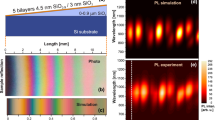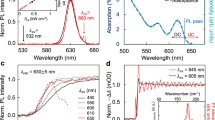Abstract
Crystalline silicon is the most important semiconductor material in the electronics industry. However, silicon has poor optical properties because of its indirect bandgap, which prevents the efficient emission and absorption of light. The energy structure of silicon can be manipulated through quantum confinement effects, and the excitonic emission from silicon nanocrystals increases in intensity and shifts to shorter wavelengths (a blueshift) as the size of the nanocrystals is reduced. Here we report experimental evidence for a short-lived visible band in the photoluminescence spectrum of silicon nanocrystals that increases in intensity and shifts to longer wavelengths (a redshift) with smaller nanocrystal sizes. This higher intensity indicates an increased quantum efficiency, which for 2.5-nm-diameter nanocrystals is enhanced by three orders of magnitude compared to bulk silicon. We assign this band to the radiative recombination of non-equilibrium electron–hole pairs in a process that does not involve phonons.
This is a preview of subscription content, access via your institution
Access options
Subscribe to this journal
Receive 12 print issues and online access
$259.00 per year
only $21.58 per issue
Buy this article
- Purchase on Springer Link
- Instant access to full article PDF
Prices may be subject to local taxes which are calculated during checkout





Similar content being viewed by others
References
Rong, H. S. et al. An all-silicon Raman laser. Nature 433, 292–294 (2005).
Cloutier, S. G., Kossyrev, P. A. & Xu, J. Optical gain and stimulated emission in periodic nanopatterned crystalline silicon. Nature Mater. 4, 887–891 (2005).
Koshida, N. (ed.) Nanostructure Science and Technology: Device Applications of Silicon Nanocrystals and Nanostructures (Springer, 2008).
Cullis, A. G. & Canham, L. T. Visible light emission due to quantum size effects in highly porous crystalline silicon. Nature 353, 335–338 (1991).
Belyakov, V. A., Burdov, V. A., Lockwood, R. & Meldrum, A. Silicon nanocrystals: fundamental theory and implications for stimulated emission. Adv. Opt. Technol. 2008, 279502 (2008).
Kovalev, D., Heckler, H., Polisski, G. & Koch, F. Optical properties of Si nanocrystals. Phys. Status Solidi b 215, 871–932 (1999).
Wilson, W. L., Szajowski, P. F. & Brus, L. E. Quantum confinement in size-selected, surface-oxidized silicon nanocrystals. Science 262, 1242–1244 (1993).
Sykora, M. et al. Size-dependent intrinsic radiative decay rates of silicon nanocrystals at large confinement energies. Phys. Rev. Lett. 100, 067401 (2008).
Pavesi, L., Dal Negro, L., Mazzoleni, C., Franzò, G. & Priolo, F. Optical gain in silicon nanocrystals. Nature 408, 440–444 (2000).
Park, J.-H et al. Biodegradable luminescent porous silicon nanoparticles for in vivo applications. Nature Mater. 8, 331–336 (2009).
Beard, M. C. et al. Multiple exciton generation in colloidal silicon nanocrystals. Nano Lett. 7, 2506–2512 (2007).
Timmerman, D., Izeddin, I., Stallinga, P., Yassievich, I. N. & Gregorkiewicz, T. Space-separated quantum cutting with Si nanocrystals for photovoltaic applications. Nature Photon. 2, 105–109 (2008).
Schaller, R. D. Agranovich, V. M. & Klimov, V. I. High-efficiency carrier multiplication through direct photogeneration of multi-excitons via virtual single-excitons. Nature Phys. 1, 189–194 (2005).
Shabaev, A., Efros, Al. L. & Nozik, A. J. Multiexciton generation by a single photon in nanocrystals. Nano Lett. 6, 2856–2863 (2006).
Rama Krishna, M. V. & Friesner, R. A. Prediction of anomalous red shift in semiconductor clusters. J. Chem. Phys. 96, 873–877 (1992).
Babić, D. & Tsu, R. Excitons in silicon nanocrystallites. Superlattice Microstruct. 22, 581–588 (1997).
Moskalenko, A. S., Berakdar, J., Prokofiev, A. A. & Yassievich, I. N. Single-particle states in spherical Si/SiO2 quantum dots. Phys. Rev. B 76, 085427 (2007).
Prokofiev, A. A. et al. Direct bandgap optical transitions in Si nanocrystals. JETP Lett. 90, 758–762 (2009).
Ben-Chorin, M., Averboukh, B., Kovalev, D., Polisski, G. & Koch, F. Influence of quantum confinement on the critical points of the band structure of Si. Phys. Rev. Lett. 77, 763–766 (1996).
Schmidt, P., Berndt, R. & Vexler, M. I. Ultraviolet light emission from Si in a scanning tunneling microscope. Phys. Rev. Lett. 99, 246103 (2007).
Alivisatos, A. Semiconductor clusters, nanocrystals, and quantum dots. Science 271, 933–937 (1996).
Pandey, A. & Guyot-Sionnest, P. Slow electron cooling in colloidal quantum dots. Science 332, 929–932 (2008).
Wang, L.-W., Califano, M., Zunger, A. & Franceschetti, A. Pseudopotential theory of Auger processes in CdSe quantum dots. Phys. Rev. Lett. 91, 056404 (2003).
Allan, G. & Delerue, C. Fast relaxation of hot carriers by impact ionization in semiconductor nanocrystals: role of defects. Phys. Rev. B 79, 195324 (2009).
Trojánek, F., Neudert, K., Bittner, M. & Malý, P. Picosecond photoluminescence and transient absorption in silicon nanocrystals. Phys. Rev. B 72, 075365 (2005).
Achermann, M., Hollingsworth, J. A. & Klimov, V. I. Multiexcitons confined within a subexcitonic volume: spectroscopic and dynamical signatures of neutral and charged biexcitons in ultrasmall semiconductor nanocrystals. Phys. Rev. B 68, 245302 (2003).
Brewer, A. & Von Haeften, K. In situ passivation and blue luminescence of silicon clusters using a cluster beam/H2O codeposition production method. Appl. Phys. Lett. 94, 261102 (2009).
Grom, G. F. et al. Ordering and self-organization in nanocrystalline silicon. Nature 407, 358–361 (2000).
Delley, B. & Steigmeier, E. F. Quantum confinement in Si nanocrystals. Phys. Rev. B 47, 1397–1400 (1993).
Wolkin, M. V., Jorne, J., Fauchet, P. M., Allan, G. & Delerue, C. Electronic states and luminescence in porous silicon quantum dots: the role of oxygen. Phys. Rev. Lett. 82, 197–200 (1999).
Godefroo, S. et al. Classification and control of the origin of photoluminescence from Si nanocrystals. Nature Nanotech. 3, 174–178 (2008).
Stathis, J. H. & Kastner, M. A. Time-resolved photoluminescence in amorphous silicon dioxide. Phys. Rev. B 35, 2972–2979 (1987).
Puzder, A., Williamson, A. J., Grossman, J. C. & Galli, G. Surface chemistry of Si nanoclusters. Phys. Rev. Lett. 88, 097401 (2002).
Valenta, J. et al. On the origin of the fast photoluminescence band in small silicon nanoparticles. New J. Phys. 10, 073022 (2008).
Kanemitsu, Y. Luminescence properties of nanometer-sized Si crystallites: Core and surface states. Phys. Rev. B 49, 16845–16848 (1994).
Rao, S., Mantey, K., Therrien J., Smith A. & Nayfeh, M. Molecular behavior in the vibronic and excitonic properties of hydrogenated silicon nanoparticles. Phys. Rev. B 76, 155316 (2007).
Tsybeskov, L., Vandyshev, Ju. V. & Fauchet, P. M. Blue emission in porous silicon: oxygen-related luminescence. Phys. Rev. B 49, 7821–7824 (1994).
Luo, J.-W, Franceschetti, A. & Zunger, A. Quantum-size-induced electronic transitions in quantum dots: indirect band-gap GaAs. Phys. Rev. B 78, 035306 (2008).
Liu, J. et al. Waveguide-integrated, ultralow-energy GeSi electro-absorption modulators. Nature Photon. 2, 433–437 (2008).
Jurbergs, D., Rogojina, E., Mangolini, L. & Kortshagen, U. Silicon nanocrystals with ensemble quantum yield exceeding 60%. Appl. Phys. Lett. 88, 233116 (2006).
Ledoux, G. et al. Photoluminescence properties of silicon nanocrystals as a function of their size. Phys. Rev. B 62, 15942–15951 (2000).
Walters, J. R., Bourianoff, G. I. & Atwater, H. A. Field-effect electroluminescence in silicon nanocrystals. Nature Mater. 4, 143–146 (2005).
Takeoka, S., Fujii, M. & Hayashi, S. Size-dependent photoluminescence from surface-oxidized Si nanocrystals in a weak confinement regime. Phys. Rev. B 62, 16820–16825 (2000).
Kanzawa, Y. et al. Size-dependent near-infrared photoluminescence spectra of Si nanocrystals embedded in SiO2 matrices. Solid State Commun. 102, 533–537 (1997).
Acknowledgements
The authors thank M. Fujii (Kobe University) for sharing expertise on the preparation of sputtered layers, A.N. Poddubny, A.A. Prokofiev and A.S. Moskalenko (A.F. Ioffe Physico-Technical Institute) for discussions and theoretical insights, D. Bebelaar (University of Amsterdam) for technical assistance, and K. van der Vaart for contributing to the initial phase of the experiments. This work was financially supported by Stichting voor de Technologische Wetenschappen (STW), Stichting der Fundamenteel Onderzoek der Materie (FOM), and Nederlandse Organisatie voor Wetenschappelijk Onderzoek (NWO).
Author information
Authors and Affiliations
Contributions
W.d.B. and T.G. conceived the project, designed the experiments and co-wrote the manuscript. W.d.B. performed experiments and data analysis. D.T. prepared the Si-NC layers. I.N.Y. provided theoretical interpretations and modelling. K.D. contributed essentially to finalization of the manuscript. H.Z. and W.J.B. facilitated picosecond PL spectroscopy and provided the necessary expertise. T.G. supervised and facilitated the project. All authors discussed the results and commented on the manuscript.
Corresponding author
Ethics declarations
Competing interests
The authors declare no competing financial interests.
Rights and permissions
About this article
Cite this article
de Boer, W., Timmerman, D., Dohnalová, K. et al. Red spectral shift and enhanced quantum efficiency in phonon-free photoluminescence from silicon nanocrystals. Nature Nanotech 5, 878–884 (2010). https://doi.org/10.1038/nnano.2010.236
Received:
Accepted:
Published:
Issue Date:
DOI: https://doi.org/10.1038/nnano.2010.236
This article is cited by
-
Highly efficient nonlinear optical emission from a subwavelength crystalline silicon cuboid mediated by supercavity mode
Nature Communications (2022)
-
Pleomorphism and multidirectional combination of Si crystal nucleation during solidification
Journal of Materials Science (2021)
-
Optical Properties of Silicon Nano-Structures: Metal Assisted Chemical Etching and a Two-Stage Ion Implantation
Silicon (2021)
-
Structural and Photoluminescence Properties of nc-SiOx:H/a-SiOx:H Multilayer Films Deposited at Low Temperature by VHF-PECVD Technique
Journal of Inorganic and Organometallic Polymers and Materials (2019)
-
Influence of metal assisted chemical etching time period on mesoporous structure in as-cut upgraded metallurgical grade silicon for solar cell application
Journal of Materials Science: Materials in Electronics (2019)



